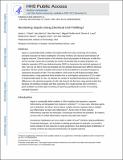| dc.contributor.author | Prieto Tejedor, Javier | |
| dc.contributor.author | Su, Hao-wei | |
| dc.contributor.author | Hou, Han Wei | |
| dc.contributor.author | Vera, Miguel Pinilla | |
| dc.contributor.author | Levy, Bruce D. | |
| dc.contributor.author | Baron, Rebecca M. | |
| dc.contributor.author | Han, Jongyoon | |
| dc.contributor.author | Voldman, Joel | |
| dc.contributor.author | han, jongyoon | |
| dc.date.accessioned | 2019-07-03T18:08:39Z | |
| dc.date.available | 2019-07-03T18:08:39Z | |
| dc.date.issued | 2016-09-22 | |
| dc.date.submitted | 2016-07-24 | |
| dc.identifier.issn | 1473-0197 | |
| dc.identifier.issn | 1473-0189 | |
| dc.identifier.uri | https://hdl.handle.net/1721.1/121486 | |
| dc.description.abstract | Sepsis is a potentially lethal condition that might benefit from early monitoring of circulating activated leukocytes for faster stratification of severity of illness and improved administration of targeted treatment. Characterization of the intrinsic electrical properties of leukocytes is lable-free and can provide a quick way to quantify the number of activated cells as sepsis progresses. Isodielectric separation (IDS) uses dielectrophoresis (DEP) to characterize the electrical signatures of cells. Here we use IDS to show that activated and non-activated leukocytes have different electrical properties. We then present a double-sided version of the IDS platform to increase throughput to
characterize thousands of cells. This new platform is less prone to cell fouling and allows faster characterization. Using peripheral blood samples from a cecal-ligation and puncture (CLP) model of polymicrobial sepsis in mice, we estimate the number of activated leukocytes by looking into differences in the electrical properties of cells. We show for the first time using animal models that electrical cell profiling correlates with flow cytometry (FC) results and that IDS is therefore a good candidate to provide rapid monitoring of sepsis by quantifying the number of circulating
activated leukocytes. | en_US |
| dc.description.sponsorship | National Institutes of Health (U.S.) (U24AI118656) | en_US |
| dc.description.sponsorship | Space and Naval Warfare Systems Center San Diego (U.S.) (N66001-11-1-4182) | en_US |
| dc.language.iso | en | |
| dc.publisher | Royal Society of Chemistry (RSC) | en_US |
| dc.relation.isversionof | 10.1039/c6lc00940a | en_US |
| dc.rights | Creative Commons Attribution-Noncommercial-Share Alike | en_US |
| dc.rights.uri | http://creativecommons.org/licenses/by-nc-sa/4.0/ | en_US |
| dc.source | PMC | en_US |
| dc.title | Monitoring sepsis using electrical cell profiling | en_US |
| dc.type | Article | en_US |
| dc.identifier.citation | Cifuentes, Diego, and Pablo A. Parrilo. “Chordal Networks of Polynomial Ideals.” SIAM Journal on Applied Algebra and Geometry 1, no. 1 (January 2017): 73–110. | en_US |
| dc.contributor.department | Massachusetts Institute of Technology. Research Laboratory of Electronics | en_US |
| dc.contributor.department | Massachusetts Institute of Technology. Department of Electrical Engineering and Computer Science | en_US |
| dc.eprint.version | Author's final manuscript | en_US |
| dc.type.uri | http://purl.org/eprint/type/JournalArticle | en_US |
| eprint.status | http://purl.org/eprint/status/PeerReviewed | en_US |
| dc.date.updated | 2019-06-05T14:07:25Z | |
| dspace.date.submission | 2019-06-05T14:07:26Z | |
| mit.journal.volume | 16 | en_US |
| mit.journal.issue | 22 | en_US |
